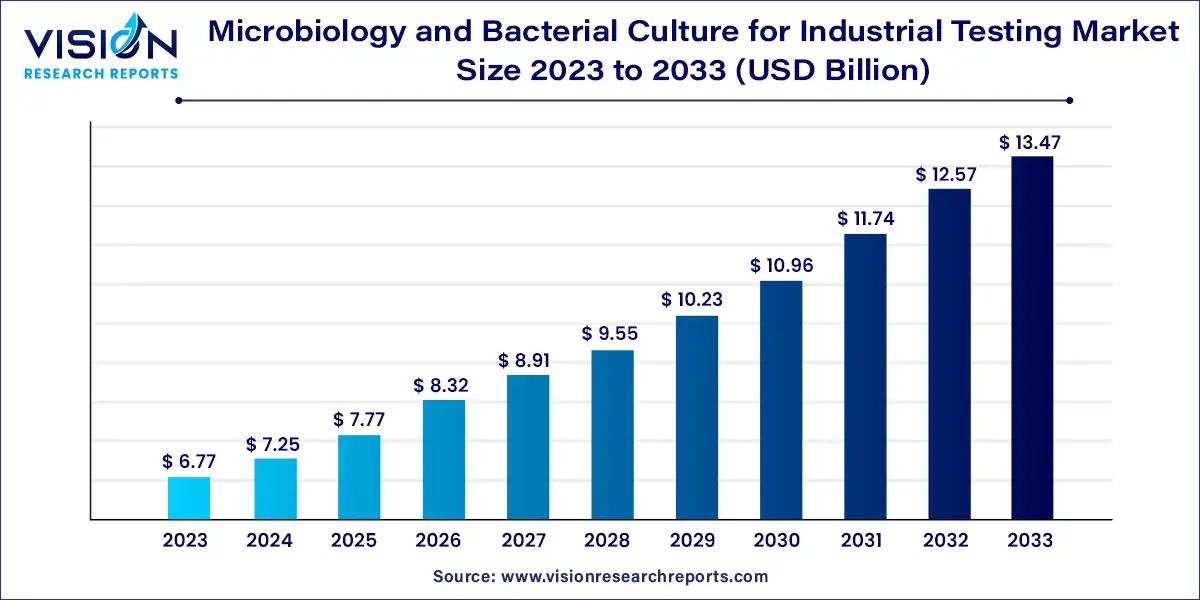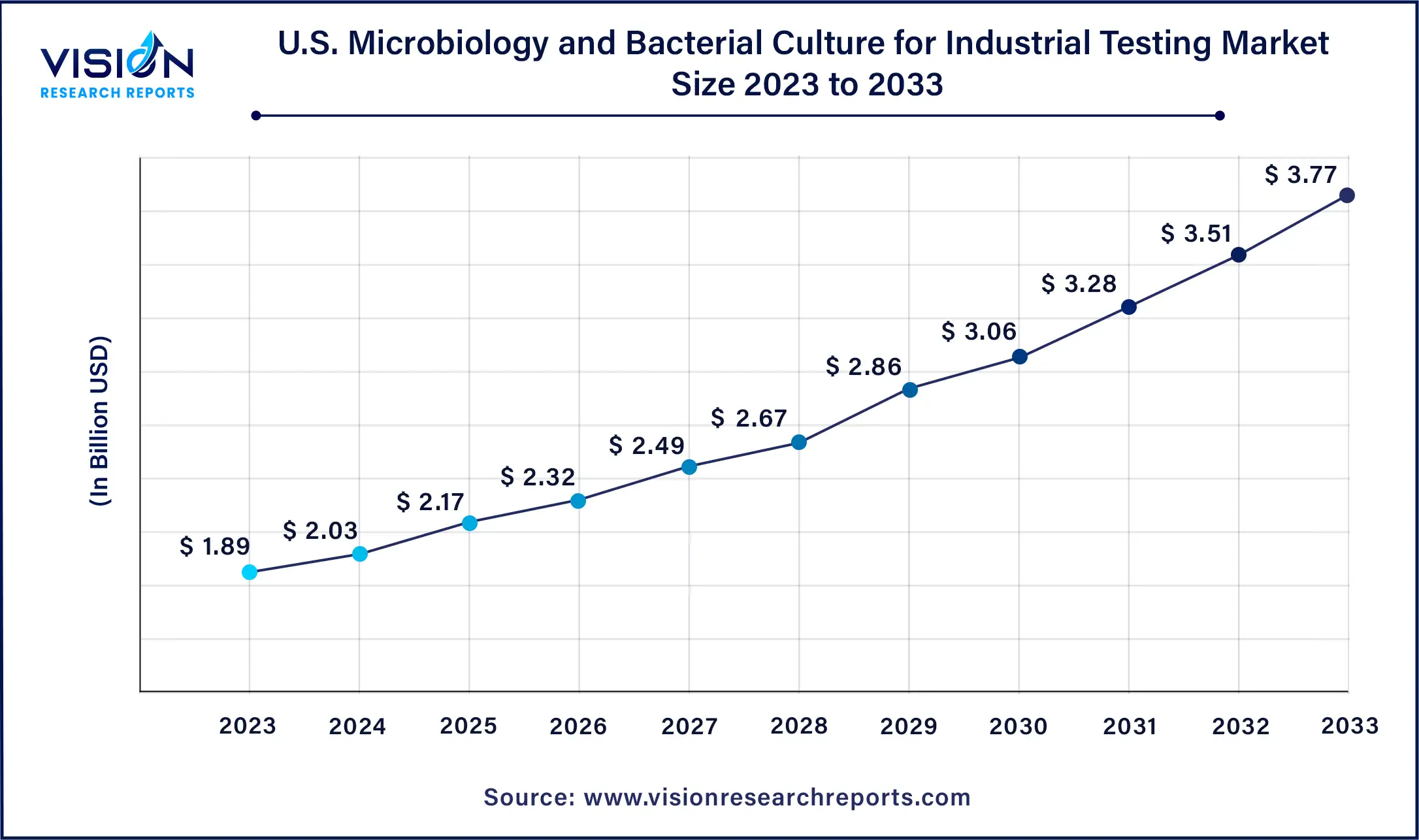The global microbiology and bacterial culture for industrial testing market size was estimated at around USD 6.77 billion in 2023 and it is projected to hit around USD 13.47 billion by 2033, growing at a CAGR of 7.12% from 2024 to 2033.

The microbiology and bacterial culture for industrial testing market is a critical segment within the broader biotechnology and pharmaceutical industries. This market encompasses various applications including food and beverage testing, pharmaceuticals, water and environmental testing, and cosmetics, ensuring product safety and quality control. The rising importance of maintaining stringent quality standards and regulatory compliance has fueled the demand for microbiological testing in various industries.
The growth of the microbiology and bacterial culture for industrial testing market is significantly driven by an escalating demand for stringent food safety standards, as consumers and regulatory bodies alike emphasize the importance of preventing foodborne illnesses. This has led to increased investment in advanced microbiological testing methods within the food and beverage industry. Additionally, the pharmaceutical sector's need for rigorous quality control measures to ensure the safety and efficacy of drugs further propels market growth. Technological advancements, such as the development of automated microbial identification systems and innovative culture media, enhance the efficiency and accuracy of testing processes, thereby attracting more industry adoption.
The U.S. microbiology and bacterial culture for industrial testing market size was estimated at USD 1.89 billion in 2023 and it is expected to surpass around USD 3.77 billion by 2033, growing at a CAGR of 7.14% from 2024 to 2033.

North America accounted for the largest market share of 40% in 2023. The local presence of a large number of biotechnology companies that operate in various fields of bioprocessing, including biofuel production, nutritional supplements, and agricultural advancements through cell culture, contributes to this dominance. Furthermore, North America has a significant market presence in terms of innovation and use of technology, particularly in microbial cell cultures. Several multinational companies have manufacturing or processing plants in North America, boosting the market in the forecast period.

The Asia Pacific microbiology & bacterial culture for industrial testing market is witnessing remarkable growth due to rising demand for quality control in various industries, increasing research activities, and advancements in microbiological techniques. This market expansion is driven by factors such as environmental monitoring, food safety, and pharmaceutical production. Moreover, the interdisciplinary approach to microbiology in the Asia Pacific has led to collaborations between microbiologists, geneticists, biochemists, and engineers, resulting in innovative solutions for addressing microbial challenges.
Based on consumables, the market is segmented into media, reagents, and sera. The media segment dominated the market with a 51% share in 2023 and is expected to register the highest CAGR over the forecast period. This growth is attributed to the substantial demand for media, crucial for cell culture composition. As bacterial cell cultivation experiences significant growth, the increased adoption of media is anticipated, fostering segment expansion. For example, in October 2022, MSL Solution Providers, which offers lab and regulatory testing services to the cleansing, personal care, and cosmetics sectors, introduced VeganSure, a vegan testing solution. This Dehydrated Culture Media (DCM) was added to their existing portfolio, allowing MSL Solution Providers to cater to global clients through in-house labs or subcontracted microbiological testing facilities. This offering enables users to conduct regular microbiological testing and uphold cosmetic product safety standards.
The reagents segment is witnessing significant expansion due to rapid growth across pharmaceuticals, chemicals, food & beverage, and other industries, increasing the need for accurate and reliable testing solutions to ensure product quality, safety, and regulatory compliance. Reagents are vital in various testing processes, including chemical analysis, environmental monitoring, material testing, and quality control. This increasing demand for testing services is fueling the reagent market as companies invest in developing and manufacturing high-quality reagents optimized for specific industrial applications. Furthermore, investments in R&D and infrastructure are driving innovation in the reagent market, leading to the development of advanced reagents with improved sensitivity, specificity, and efficiency. Companies are allocating significant resources to research initiatives aimed at enhancing reagent performance, developing novel formulations, and expanding the range of detectable analytes.
Based on application, the market is segmented into food & water testing, bioenergy & agricultural research, and others. The food & water testing segment dominated the market with a 48% share in 2023. Food and water are the easiest and most frequent ways of transferring pathogens. The growing concern for food safety, driven by increased food poisoning cases, is fueling the demand for microbiological testing solutions. To ensure pathogen-free products, global supply chains focus on maintaining microbial quality control. This heightened awareness among food manufacturing and processing entities is anticipated to significantly contribute to the market's prosperous growth in the foreseeable future.
The bioenergy & agricultural research segment is expected to register the highest CAGR over the forecast period. In the bioenergy sector, microbial culture testing plays a crucial role in biofuel production processes. Microorganisms are utilized in fermentation processes to convert biomass, such as agricultural residues and organic waste, into biofuels like ethanol and biodiesel. As the demand for renewable energy sources grows and governments implement policies to reduce reliance on fossil fuels, there is a rising emphasis on R&D in bioenergy technologies, driving the demand for microbial culture testing services. For instance, in November 2022, the Ministry of New & Renewable Energy (MNRE) under the Government of India announced the initiation of the National Bioenergy Programme. MNRE extended the National Bioenergy Programme from the fiscal year 2021-22 to 2025-26. The optimization of microbial cultures through industrial testing methods enhances fermentation efficiency, increases biofuel yields, and reduces production costs.
By Consumables
By Application
By Region
 Cross-segment Market Size and Analysis for
Mentioned Segments
Cross-segment Market Size and Analysis for
Mentioned Segments
 Additional Company Profiles (Upto 5 With No Cost)
Additional Company Profiles (Upto 5 With No Cost)
 Additional Countries (Apart From Mentioned Countries)
Additional Countries (Apart From Mentioned Countries)
 Country/Region-specific Report
Country/Region-specific Report
 Go To Market Strategy
Go To Market Strategy
 Region Specific Market Dynamics
Region Specific Market Dynamics Region Level Market Share
Region Level Market Share Import Export Analysis
Import Export Analysis Production Analysis
Production Analysis Others
Others